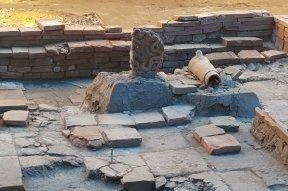
Thang Long is surely far from being the most popular WHS here. As I planned my January 2025 trip to northern Vietnam, I fully expected it to be close to the bottom of my rankings. Barely anything remains from its 11th century state that is often stated as the basis of its OUV, right? Yes, all that can be seen from that period are artifacts from the archaeological digs, and even then, the majority come from the 13th-14th centuries. Most of what remains are indeed recent Nguyen and French additions. While Nguyen structures may pale in comparison to Hue, the little gates and pavilions are distinct and beautiful royal constructions still exemplary for the period as a whole. The French colonial architecture in Hanoi is both rich and underrepresented in WHS, and this holds true for the buildings in and around the citadel too.
The 1467 Kinh Thien staircase is a subtly impressive structure from the Le Dynasty, coming right after the Ho Dynasty, with stonework that reminded me slightly of the Korean kingdoms. This would be the single oldest structure you will find within the walls of the citadel, and perhaps the most impressive (of course, that’s not saying much). Across the street, the 18 Hoang Dieu archaeological site is quite expansive, with two large zones on either side of a pond. The remains reminded me a bit of the Biblical Tells, with several layers of remains, each one older than the one above it. Occasionally, you could spot terracotta carved pieces (pictured, from Ly or Tran Dynasty period, 11th-14th century), like those in the museum, laying among the bricks. Back inside the citadel walls, another more modern highlight remains, the D67 building and bunker, built in 1967 and used by the Politburo during the infamous war against the U.S.A. Still, after a full millennium, the Thang Long Citadel was a center of power for Vietnam. Overwhelmingly, I could start to see this as the strongest argument for its OUV.
Hanoi is an amazing city, as spending 3 full days there has taught me. It is perhaps the most historic capital of Southeast Asia, with its millennia-long history etched into its modern look, framework, and culture. I don’t think a lot of us would be opposed to the notion that it is fully deserving of WHS status in some way. However, it is very hard to pinpoint a single area that would represent the city in this sense. The Old Quarter would be a very difficult area to put limitations on, as the extremely bustling heart of the city flowing with business both traditional and modern. The French Quarter is more cohesive and is home to some very significant landmarks, but only a short period of Hanoi’s long history is represented. I personally think the Citadel represents Hanoi’s entire rich and ever-changing history the best, with exemplary remains of the old Viet dynasties (no richer sites really do exist to represent the Red River civilization during this period), the Nguyen period, the French colonial period, and the independent Vietnam period. This is all while having remained a nexus of authority in Northern Vietnam for over a millennium, and at many points, the area of the modern country as a whole, thus having influence on all later cultural WHS in Vietnam. For these reasons, I do think Thang Long Citadel is actually worthy of its inscription and is an important point of interest in Hanoi in its present (mostly accessible) state.
More on
Comments
No comments yet.
